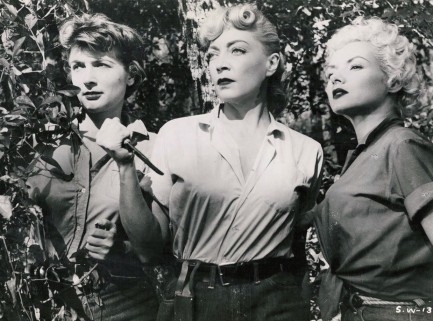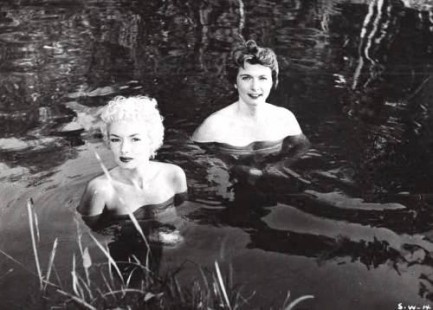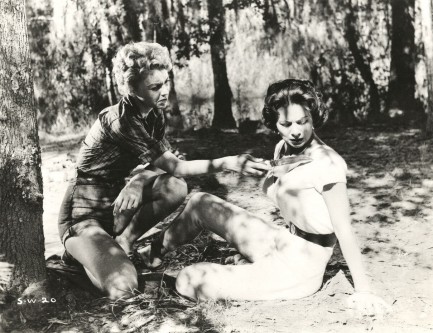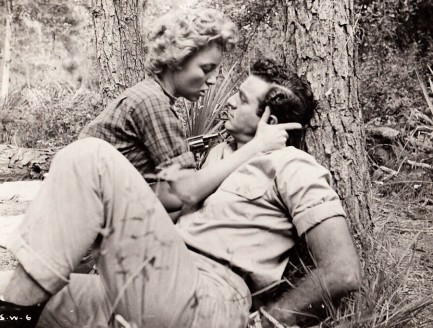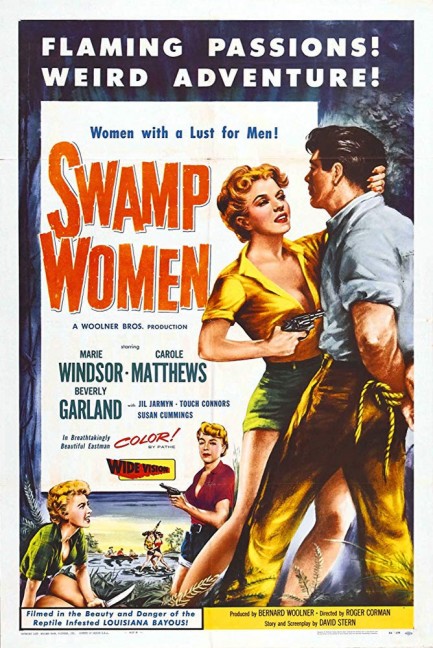 Choose your legwear like your life depends on it. 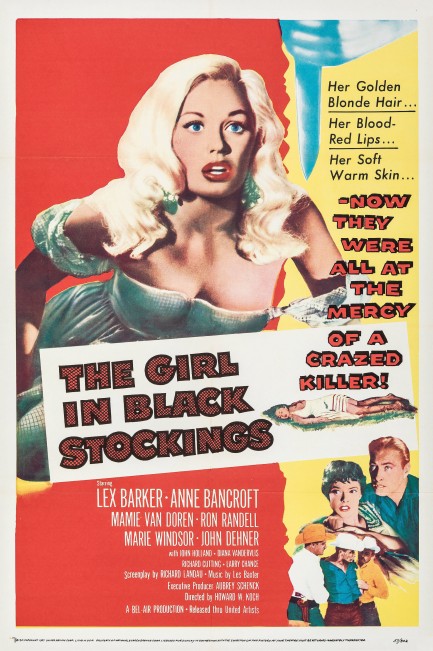
Once again, we have a poster proving that some of the worst movies had some of the best promotional art. This exemplary effort was made for The Girl in Black Stockings, which began its U.S. run today in 1957 after having its world premiere in England earlier in the year. The art showcases Mamie Van Doren, who's third billed but is the big draw. We talked about the movie last year and, shorter version, it's bad but occasionally amusing. By the way, legwear has nothing to do with the murder. The folks at Bel-Air Productions and United Artists knew they had a catchy title and simply ran with it.
 The train is headed to L.A. but some passengers make their last stop long before then. 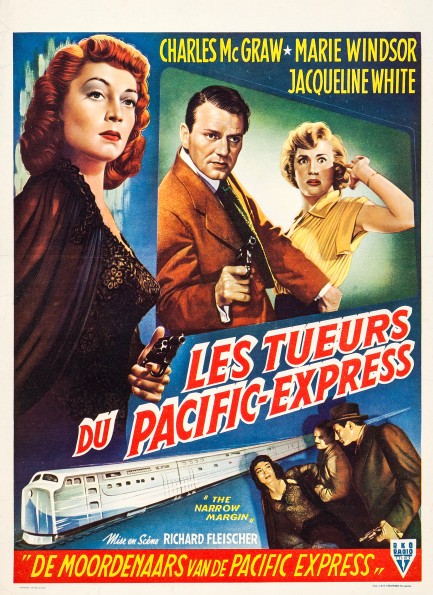
Les tueurs du Pacific Express is one of two French titles for the 1952 film noir The Narrow Margin, with Charles McGraw and Marie Windsor. The other was L'énigme du Chicago Express, which was used for France. But the above poster is Belgian, which you can always tell because there's also a Dutch title—in this case De moordenaars van de Pacific Express. We've already shown you the U.S. and Italian promos for this, so if you're interested you can click over to those and learn a bit more about the film. It premiered in Belgium today in 1953.
 Even Powell and Loy's legendary act was bound to get tired eventually. 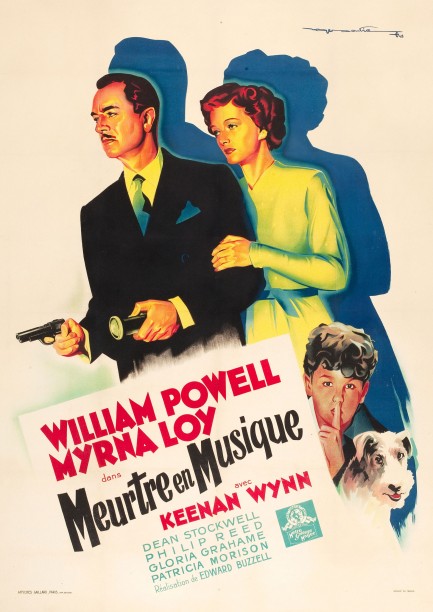
There's nice Roger Soubie art on this French poster for Song of the Thin Man, the last of six movies in the Thin Man series, which premiered in the U.S. in 1947 and reached France today in 1948. After six sessions the concept might seem a little worn to some viewers, but it still has William Powell and Myrna Loy as the leads. The mystery involves the death of an orchestra musician and the search for a missing bandleader, which leads to Powell and Loy exploring New York City's jazz underground. It's an all-white underground spread across various clubs, gambling boats, and parties, populated by at least fifty musicians, none of them of color. Of all the sight gags in the movie, the barring of black musicians from a film revolving around the art form they invented is the most notable one of all, but that's mid-century moviemaking for you.
The jazz gimmick is useful anyway, because it gives the filmmakers the opportunity to have Powell—as upper class supersleuth Nick Charles—play the role of a fish out of water. He understands neither the hipster jazzcats nor their customs and slang, and in about half a decade probably turns into the white-haired bartender from The Wild One. Even so, he needs to find and unmask a murderer in order to free a wrongly accused acquaintance from police custody. In true Thin Man fashion, he quips his way through the proceedings, plays cagey with femmes fatales Marie Windsor and Gloria Grahame, and finally unveils the killer in a nightclub populated by all the suspects. Loy is reliable as always in the sidekick role, and even amusingly picks up a few words of hep lingo.
While Dashiell Hammett originated the two characters of Nick and Nora Charles, he didn't touch Song of the Thin Man. Instead it was written by veteran crime novelist Steve Fisher and comedy writer Nat Perrin. Their union, unlike Nick and Nora's marriage, is an uneasy pairing, though it's hard to put a finger on what exactly is wrong. The mystery has an interesting backdrop, but is never compelling, while the humor seems clunkier than in the past. Powell and Loy do their best, but the movie failed to earn back its production budget, and the franchise came to an end. There were screenwriting and production issues, but we suspect that the real culprit was simple boredom—slayer of movie series and marriages alike. Audiences had simply moved on. World War, generational cynicism, and the emergence of grittier cinema will tend to cause that. Song of the Thin Man premiered today in 1947.
 Mamie Van Doren can add value to anything, but even she can't save The Girl in Black Stockings. 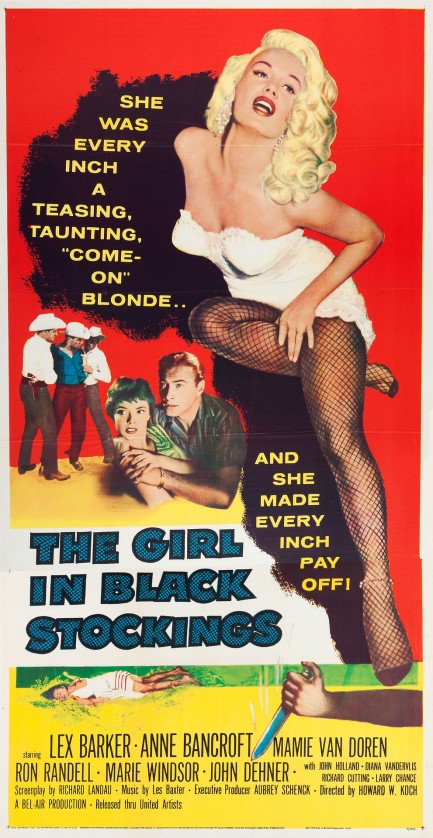
This bright poster was made for the b-drama The Girl in Black Stockings. It had its world premiere in England today in 1957 and, in contrast to the art, is a colorless murder mystery set in and around a lodge hotel in a tiny western U.S. town—the kind of place where, you know, “nothing like this has ever happened before.” Lex Barker stars as a Los Angeles lawyer who goes to this arid little stopover for peace and quiet, but discovers a body that's been mutilated as though by a psychopath. A county official warns, “The type that did this—they don't stop with just one.”
Sure enough, more deaths follow and—as doctors are wont to do—Lex inserts himself right into the middle of the investigation. His professional acumen is needed. There are a lot of suspects. Anne Bancroft as the local beauty, Mamie Van Doren as a stereotypical blonde floozy, Ron Randell as a woman hating lodge owner who's confined to a wheelchair—or is he?—and Marie Windsor as his unhealthily attached spinster sister are all under the suspicious gaze of the plodding but tenacious sheriff John Dehner.
Sadly, the mystery isn't compelling and the dramatic aspects of the narrative are blah because none of the characters are interesting. All the main actors have done well in other movies, but here they're hobbled by a poor script, particularly Randell, who's forced to mouth numerous cynical and self pitying soliloquies. Van Doren, who we feel confident saying cannot act, is also bad here. She has a drunk scene that will make you cringe, it's so wooden.
The end result is a dismissable movie that's only barely remembered because it was shot in Utah, which provides some nice scenery, and because it has Van Doren, who was obviously cast to provide a different type of scenery, and achieves that function with ease. We'll always take a look at any film in which she appears. She's no Marilyn. But she's not far behind. Yet even with her presence and some long looks at the Beehive State, we can't recommend The Girl in Black Stockings.
 Oh good Lord! She's been murdered and mutilated beyond recognition! Somebody call a doctor! Oh good Lord! She's been murdered and mutilated beyond recognition! Somebody call a doctor!
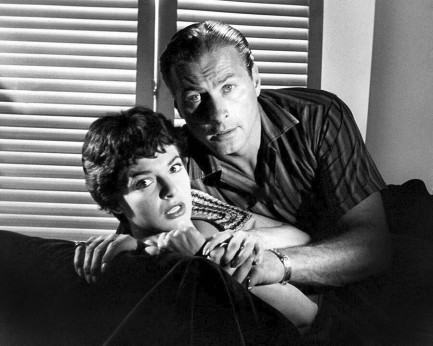 What the..! Don't you knock? I'm in the midst of a consultation here! What the..! Don't you knock? I'm in the midst of a consultation here!
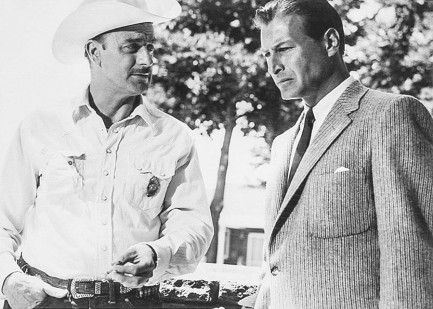 I can advise you only informally until I hear back from the town's insurance network, Sheriff. But you might start with an immediate canvassing effort and a check for similar crimes in the state going back at least ten years. I can advise you only informally until I hear back from the town's insurance network, Sheriff. But you might start with an immediate canvassing effort and a check for similar crimes in the state going back at least ten years.
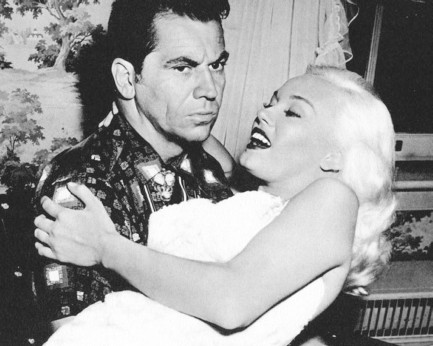 Actually, knowing there's a killer on the loose and any of us could be snuffed out next doesn't make me horny, Diana. But thanks for thinking of me. Actually, knowing there's a killer on the loose and any of us could be snuffed out next doesn't make me horny, Diana. But thanks for thinking of me.
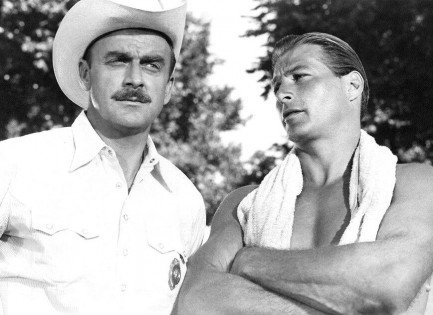 Well, Sheriff, turns out the town has a three murder deductible. I'm afraid my hands are tied until a fourth person is slain. Well, Sheriff, turns out the town has a three murder deductible. I'm afraid my hands are tied until a fourth person is slain.
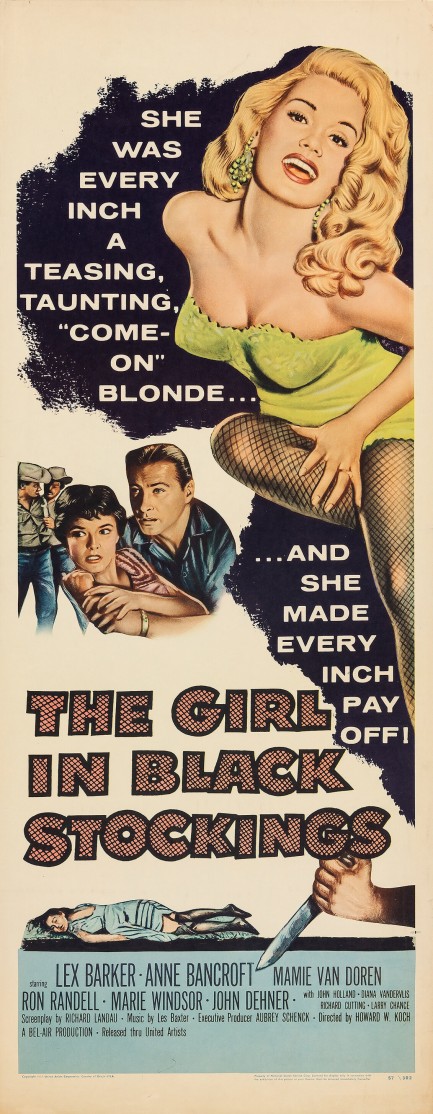
 If you use the sleeper car you might never wake up. 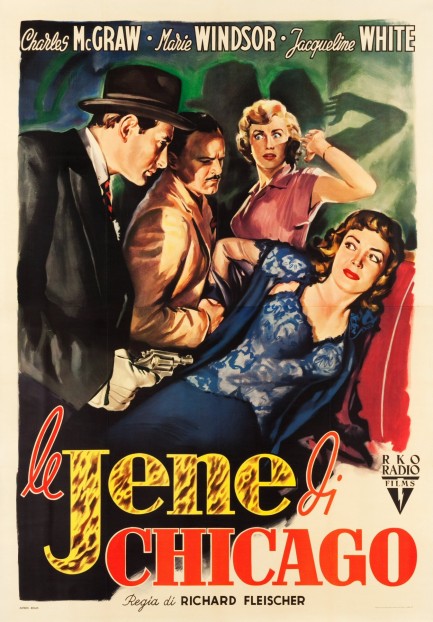
This Italian poster for was made to promote Le jene di Chicago, which opened in Italy today in 1952, but was made in the U.S. and is better known as The Narrow Margin. It's a movie we talked about back in April. The Italian title translates as “the hyenas of Chicago,” which makes sense—a potential federal witness is dogged by a pack of predators that want to kill her. It's a movie worth watching. You can read about it here.
 They're meaner than the gators and deadlier than the snakes. 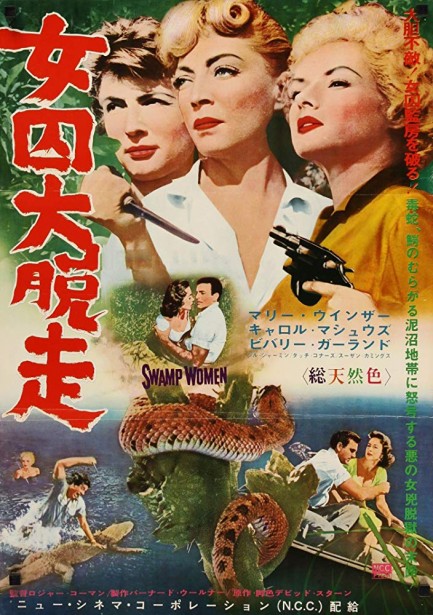
Above, a Japanese poster for Swamp Women, originally made in 1956, starring Mike Connors, Marie Windsor, Carole Matthews, and Beverly Garland. The Japanese title of this is 女囚大脱走, which means “female prisoner escape.” We consider that a bit of a plot spoiler, but the art is brilliant, and we suspect it enticed many a Japanese filmgoer. To their shock and horror, after they'd ponied up the yen they found out it was a Roger Corman b-movie and probably wanted to escape too.
 It's shocking how many Hollywood stars did smack. 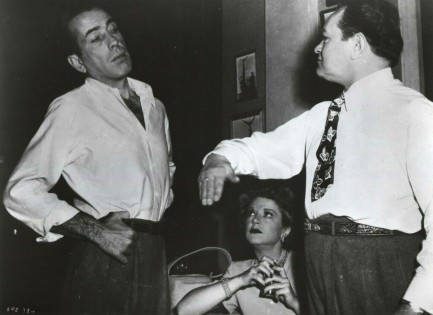
Everybody wants to slap somebody sometime. Luckily, actors in movies do it so you don't have to. The above shot is a good example. Edward G. Robinson lets Humphrey Bogart have it in 1948's Key Largo, as Claire Trevor looks on. In vintage cinema, people were constantly slapping. Men slapped men, men slapped women, women slapped women, and women slapped men. The recipient was usually the protagonist because—though some readers may not realize this—even during the ’40s and 50s, slapping was considered uncouth at a minimum, and downright villainous at worst, particularly when men did it. So generally, bad guys did the slapping, with some exceptions. Glenn Ford slaps Rita Hayworth in Gilda, for example, out of humiliation. Still wrong, but he wasn't the film's villain is our point. Humphrey Bogart lightly slaps Martha Vickers in The Big Sleep to bring her out of a drug stupor. He's like a doctor. Sort of. In any case, most cinematic slapping is fake, and when it wasn't it was done with the consent of the participants (No, really slap me! It'll look more realistic.). There are some famous examples of chipped teeth and bloody noses deriving from the pursuit of realism. We can envision a museum exhibit of photos like these, followed by a lot of conversation around film, social mores, masculinity, and their intersection. We can also envison a conversation around the difference between fantasy and reality. There are some who believe portryals of bad things endorse the same. But movies succeed largely by thrilling, shocking, and scaring audiences, which requires portraying thrilling, shocking, and frightening moments. If actors can't do that, then ultimately movies must become as banal as everyday llife. Enjoy the slapfest.
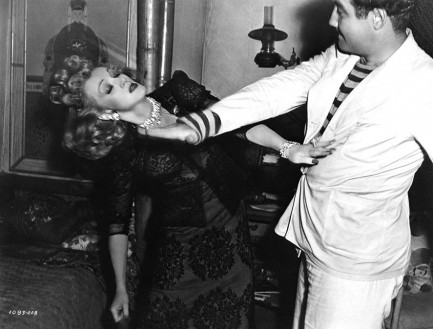 Broderick Crawford slaps Marlene Dietrich in the 1940's Seven Sinners. Broderick Crawford slaps Marlene Dietrich in the 1940's Seven Sinners.
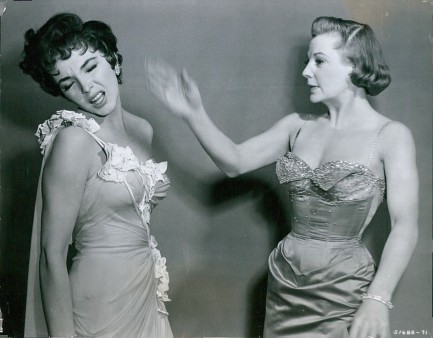 June Allyson lets Joan Collins have it across the kisser in a promo image for The Opposite Sex, 1956. June Allyson lets Joan Collins have it across the kisser in a promo image for The Opposite Sex, 1956.
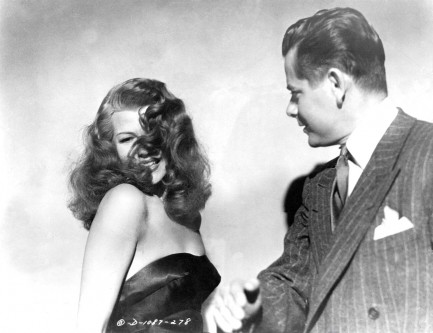 Speaking of Gilda, here's one of Glenn Ford and Rita Hayworth re-enacting the slap heard round the world. Hayworth gets to slap Ford too, and according to some accounts she loosened two of his teeth. We don't know if that's true, but if you watch the sequence it is indeed quite a blow. 100% real. We looked for a photo of it but had no luck. Speaking of Gilda, here's one of Glenn Ford and Rita Hayworth re-enacting the slap heard round the world. Hayworth gets to slap Ford too, and according to some accounts she loosened two of his teeth. We don't know if that's true, but if you watch the sequence it is indeed quite a blow. 100% real. We looked for a photo of it but had no luck.
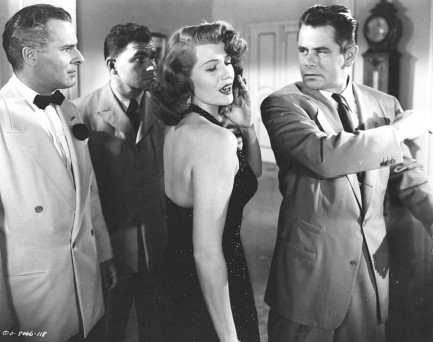 Don't mess with box office success. Ford and Hayworth did it again in 1952's Affair in Trinidad. Don't mess with box office success. Ford and Hayworth did it again in 1952's Affair in Trinidad.
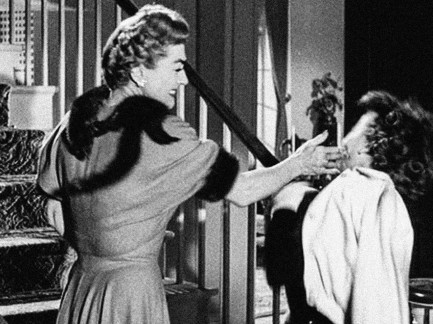 All-time film diva Joan Crawford gets in a good shot on Lucy Marlow in 1955's Queen Bee. All-time film diva Joan Crawford gets in a good shot on Lucy Marlow in 1955's Queen Bee.
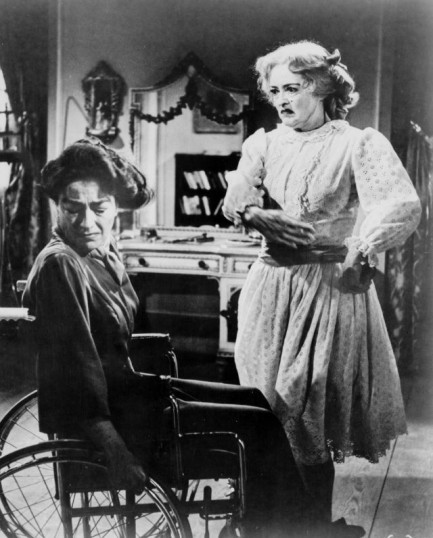 The answer to the forthcoming question is: She turned into a human monster, that's what. Joan Crawford is now on the receiving end, with Bette Davis issuing the slap in Whatever Happened to Baby Jane? Later Davis kicks Crawford, so the slap is just a warm-up. The answer to the forthcoming question is: She turned into a human monster, that's what. Joan Crawford is now on the receiving end, with Bette Davis issuing the slap in Whatever Happened to Baby Jane? Later Davis kicks Crawford, so the slap is just a warm-up.
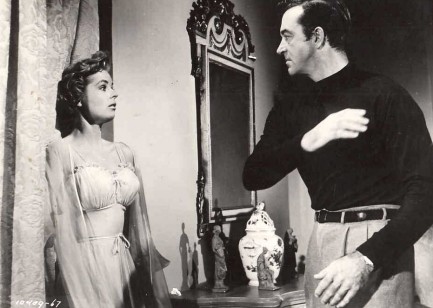 Mary Murphy awaits the inevitable from John Payne in 1955's Hell's Island. Mary Murphy awaits the inevitable from John Payne in 1955's Hell's Island.
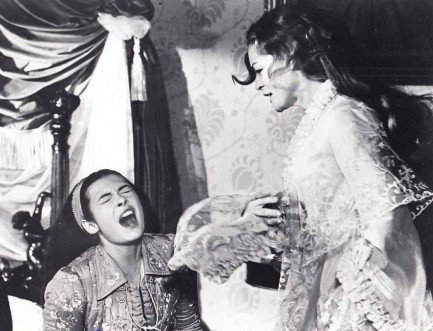 Romy Schneider slaps Sonia Petrova in 1972's Ludwig. Romy Schneider slaps Sonia Petrova in 1972's Ludwig.
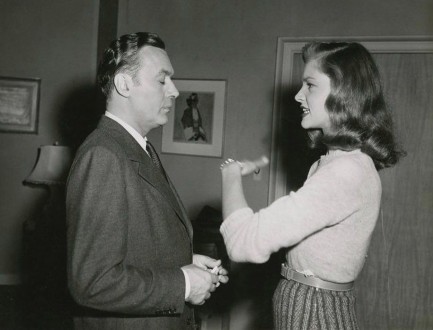 Lauren Bacall lays into Charles Boyer in 1945's Confidential Agent and garnishes the slap with a brilliant snarl. Lauren Bacall lays into Charles Boyer in 1945's Confidential Agent and garnishes the slap with a brilliant snarl.
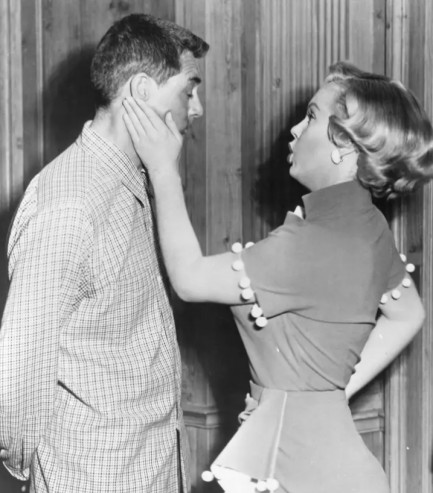 Iconic bombshell Marilyn Monroe drops a smart bomb on Cary Grant in the 1952 comedy Monkey Business. Iconic bombshell Marilyn Monroe drops a smart bomb on Cary Grant in the 1952 comedy Monkey Business.
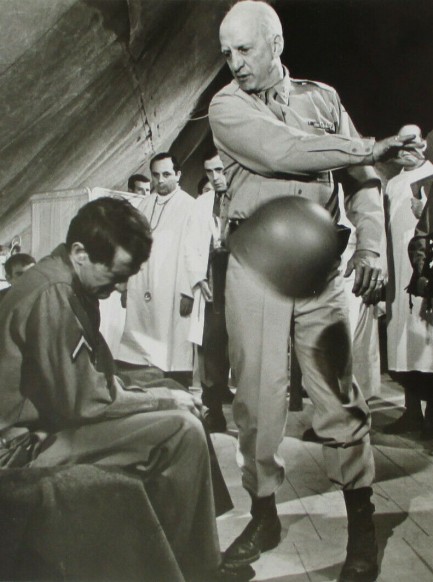 This is the most brutal slap of the bunch, we think, from 1969's Patton, as George C. Scott de-helmets an unfortunate soldier played by Tim Considine. This is the most brutal slap of the bunch, we think, from 1969's Patton, as George C. Scott de-helmets an unfortunate soldier played by Tim Considine.
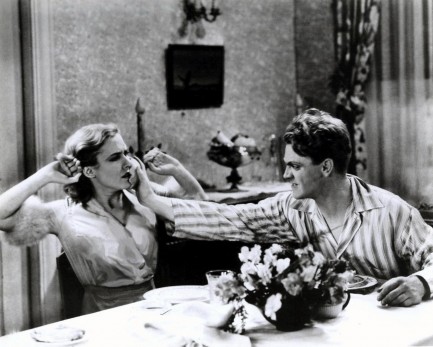 A legendary scene in filmdom is when James Cagney shoves a grapefruit in Mae Clark's face in The Public Enemy. Is it a slap? He does it pretty damn hard, so we think it's close enough. They re-enact that moment here in a promo photo made in 1931. A legendary scene in filmdom is when James Cagney shoves a grapefruit in Mae Clark's face in The Public Enemy. Is it a slap? He does it pretty damn hard, so we think it's close enough. They re-enact that moment here in a promo photo made in 1931.
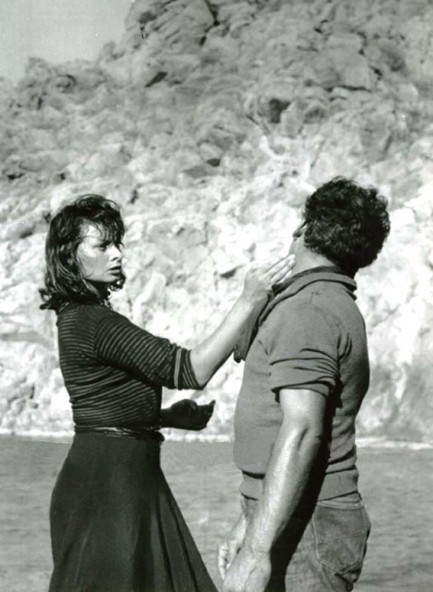 Sophia Loren gives Jorge Mistral a scenic seaside slap in 1957's Boy on a Dolphin. Sophia Loren gives Jorge Mistral a scenic seaside slap in 1957's Boy on a Dolphin.
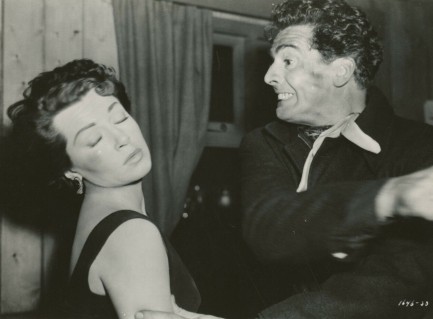 Victor Mature fails to live up to his last name as he slaps Lana Turner in 1954's Betrayed. Victor Mature fails to live up to his last name as he slaps Lana Turner in 1954's Betrayed. 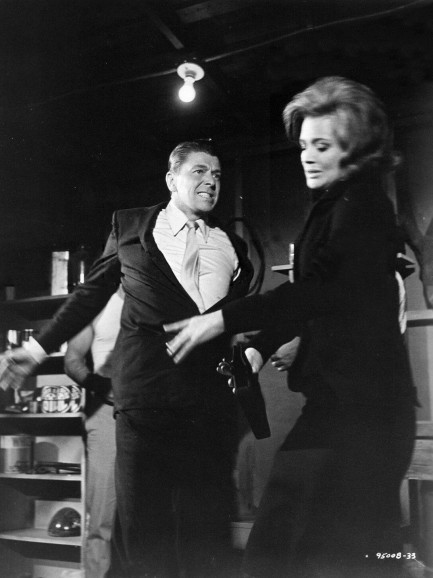 Ronald Reagan teaches Angie Dickinson how supply side economics work in 1964's The Killers. Ronald Reagan teaches Angie Dickinson how supply side economics work in 1964's The Killers.
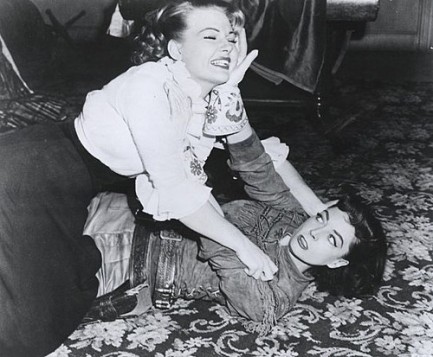 Marie Windsor gets in one against Mary Castle from the guard position in an episode of television's Stories of the Century in 1954. Windsor eventually won this bout with a rear naked choke. Marie Windsor gets in one against Mary Castle from the guard position in an episode of television's Stories of the Century in 1954. Windsor eventually won this bout with a rear naked choke.
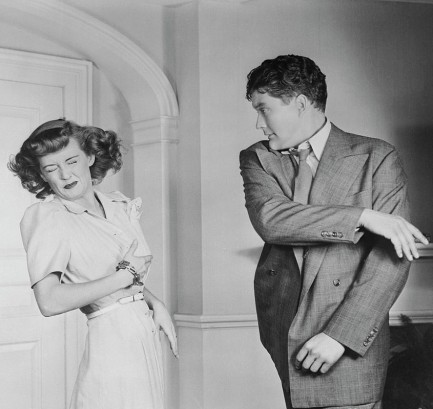 It's better to give than receive, but sadly it's Bette Davis's turn, as she takes one from Dennis Morgan in In This Our Life, 1942. It's better to give than receive, but sadly it's Bette Davis's turn, as she takes one from Dennis Morgan in In This Our Life, 1942.
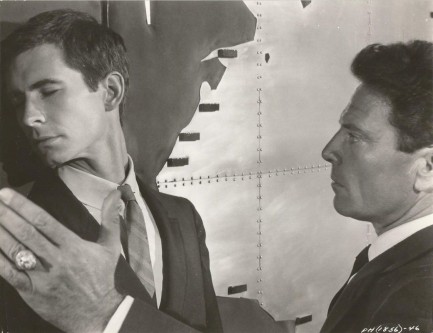 Anthony Perkins and Raf Vallone dance the dance in 1962's Phaedra, with Vallone taking the lead. Anthony Perkins and Raf Vallone dance the dance in 1962's Phaedra, with Vallone taking the lead.
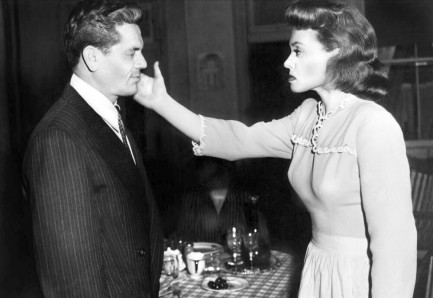 And he thought being inside the ring was hard. Lilli Palmer nails John Garfield with a roundhouse right in the 1947 boxing classic Body and Soul. And he thought being inside the ring was hard. Lilli Palmer nails John Garfield with a roundhouse right in the 1947 boxing classic Body and Soul.
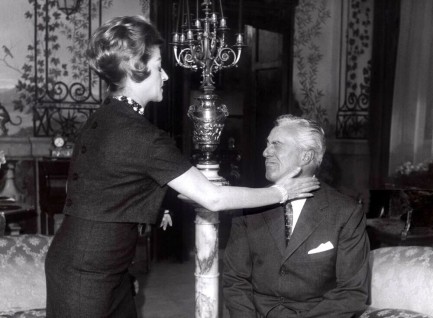 1960's Il vigile, aka The Mayor, sees Vittorio De Sica rebuked by a member of the electorate Lia Zoppelli. She's more than a voter in this—she's also his wife, so you can be sure he deserved it. 1960's Il vigile, aka The Mayor, sees Vittorio De Sica rebuked by a member of the electorate Lia Zoppelli. She's more than a voter in this—she's also his wife, so you can be sure he deserved it.
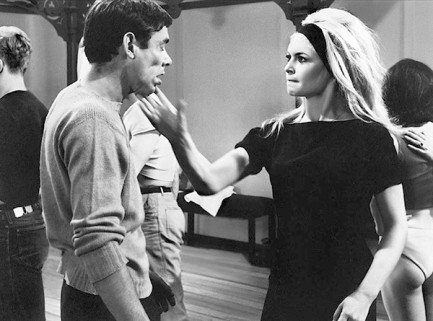 Brigitte Bardot delivers a not-so-private slap to Dirk Sanders in 1962's Vie privée, aka A Very Private Affair. Brigitte Bardot delivers a not-so-private slap to Dirk Sanders in 1962's Vie privée, aka A Very Private Affair.
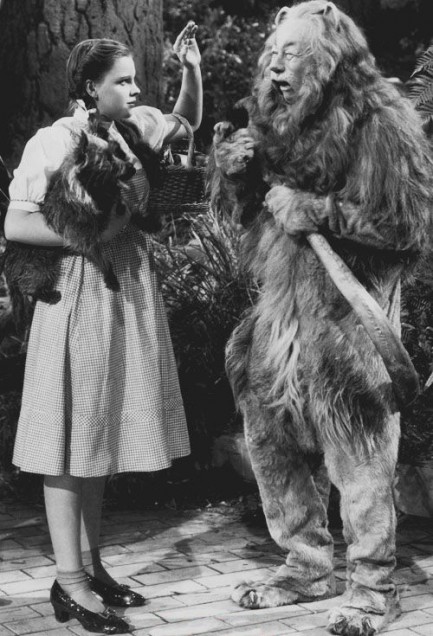 In a classic case of animal abuse. Judy Garland gives cowardly lion Bert Lahr a slap on the nose in The Wizard of Oz. Is it his fault he's a pussy? Accept him as he is, Judy. In a classic case of animal abuse. Judy Garland gives cowardly lion Bert Lahr a slap on the nose in The Wizard of Oz. Is it his fault he's a pussy? Accept him as he is, Judy.
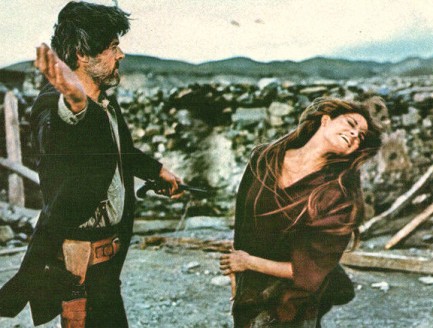 Robert Culp backhands Raquel Welch in 1971's Hannie Caudler. Robert Culp backhands Raquel Welch in 1971's Hannie Caudler.
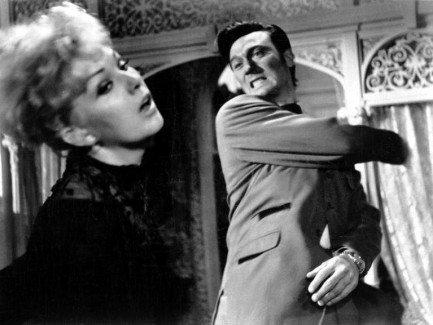 And finally, Laurence Harvey dares to lay hands on the perfect Kim Novak in Of Human Bondage. And finally, Laurence Harvey dares to lay hands on the perfect Kim Novak in Of Human Bondage.
 The walls close in on a cop and his witness in a trainbound crime thriller. 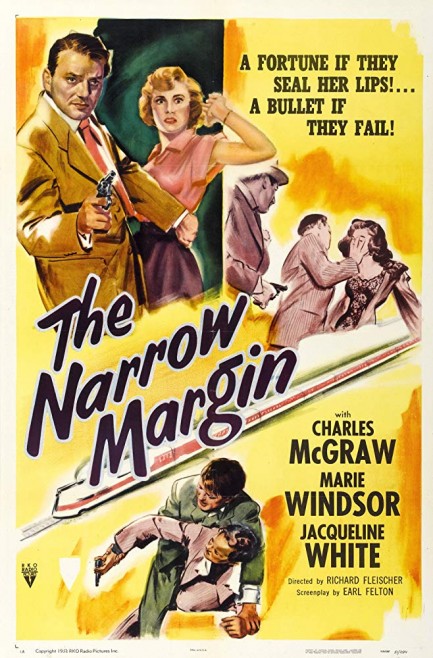
Another b-movie makes good, as inexpensive little film noir The Narrow Margin turns out to be an excellent expenditure of time. It's built around a great premise—tough cop Charles McGraw is tasked with escorting the widow of a gang lord from Chicago to Los Angeles to testify in a graft probe. A shadowy cabal of crooks plans to stop this at all costs, so the question is whether McGraw can get his witness to L.A. alive. The widow/femme fatale is played by Marie Windsor of the cool Kubrick noir The Killing and the not-cool prison break thriller Swamp Women, and here she has a role perfectly suited for her as a jaded and selfish mobster's moll. She oozes cynicism as McGraw tries to reconcile his hatred for her with his duty as a public servant, but there's more to her than he knows, and Jacqueline White as another passenger is full of surprises too. With much of the film taking place in the various cars and compartments of a train, the visuals and title mirror each other, and the same is true thematically, as the killers slowly close in, creating increasingly constrained circumstances for McGraw. With clever noir stylings, a plot that draws you in from the first minutes, and a surprising switcheroo, The Narrow Margin is a winner. It was remade in 1990 with Gene Hackman and Anne Archer, but the first and better version premiered in the U.S. today in 1952. 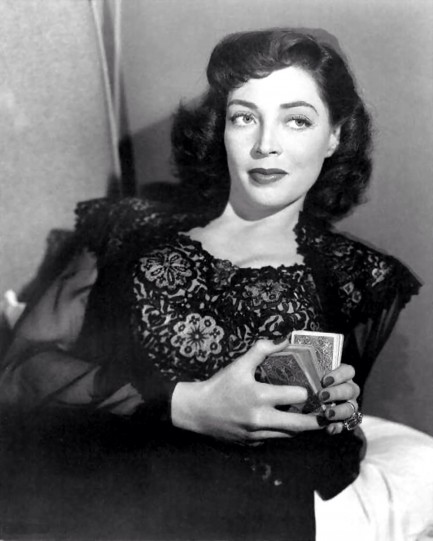 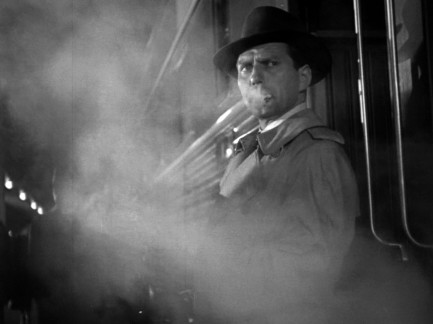 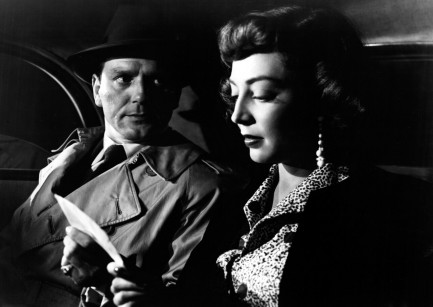 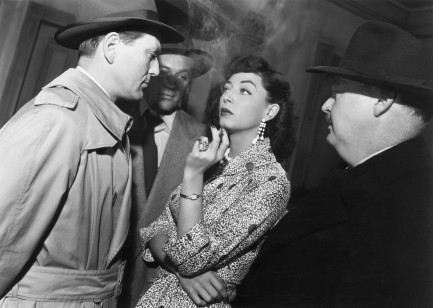 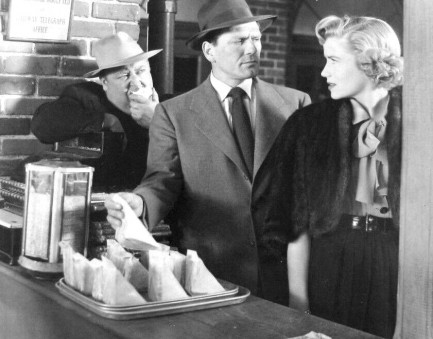 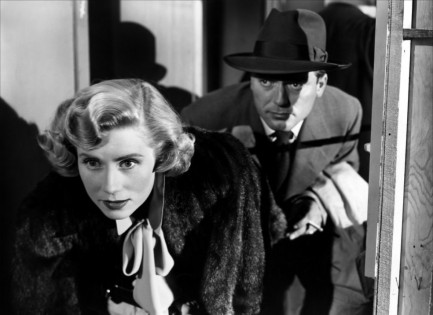 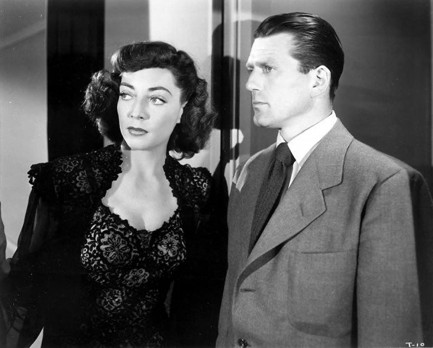 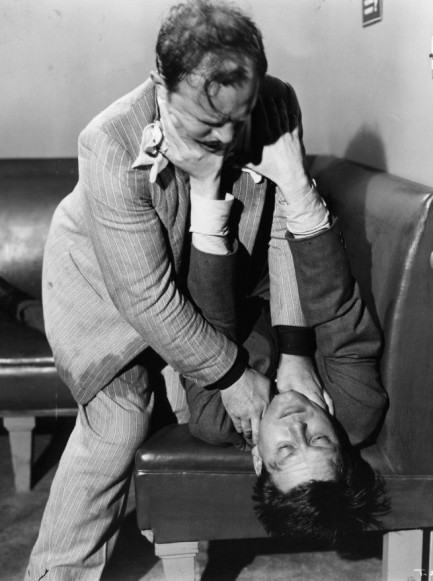 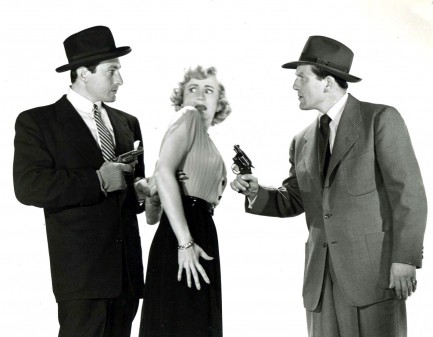
 No time to wallow in the mire. 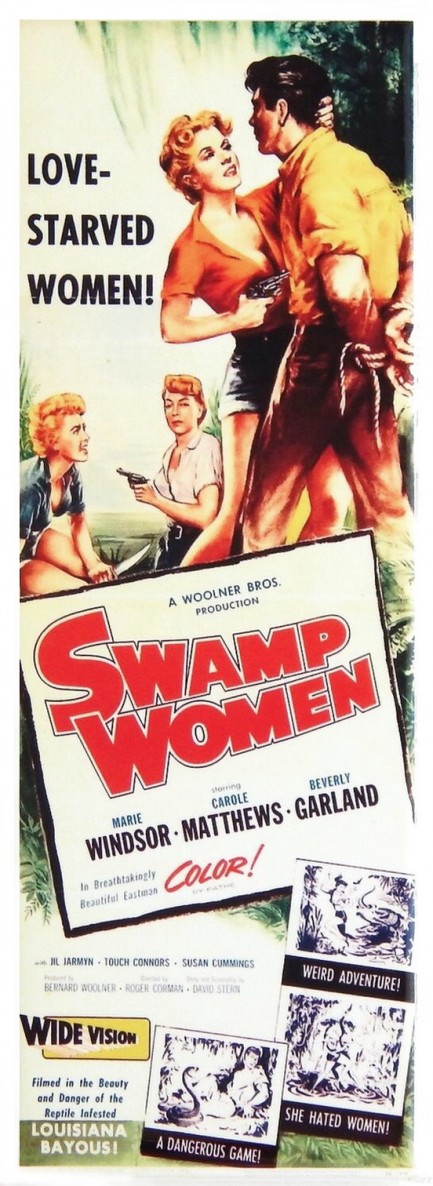
Above is a poster for the Roger Corman produced b-movie Swamp Women, which starred Marie Windsor, Carole Matthews, Beverly Garland, and Mike Connors, the latter acting under the name Touch Connors. Connors was Armenian-American and thought—correctly, we suspect—that his real name Krekor Ohanian wasn't going to help his show business career. He accumulated at least twenty credits as Touch Connors before he jettisoned it and eventually became the guy everyone remembers from the cop show Mannix.
In Swamp Women Connors plays an oil prospector boating around the Louisiana bayou who stumbles across a group of escaped female convicts searching for a stash of diamonds. Among their number is an undercover police woman charged with finding the stones and apprehending the group. It's fully as ridiculous as it sounds, and with Corman at the helm you know it's cheap, too. Plus this was only his fourth full directing gig. But we give him credit—he really made his cast slog through the Louisiana mire, which means you get realism to offset the use of stock footage.
The thing about Corman is that he always did more with less. But despite his particular set of skills, the script here hamstrings any attempt at making a decent flick. As an example of what we mean, Mike Connors doesn't go into the swamp alone. He takes his girlfriend with him, and she's eaten by an alligator. Hours later he's smooching the undercover policewoman. Not as part of a ruse or escape attempt. Just because he digs her. His girlfriend was a gold digging pain in the ass, but still, you'd think seeing her ripped to pieces would cool his ardor. But they don't call him Touch Connors for nothing. Plenty more fish in the bayou.
If you look on Wikipedia Swamp Women is classified as a film noir. That's purely comical. It's a proto-exploitation flick along the lines of what American International Pictures would routinely do fifteen years later with more skin and better efx. By the time the swamp women finally reach the site of the hidden diamonds and dig up a box, you'll be hoping they open it and find a new script and more investment money. But no such luck. Corman would do better later. Windsor, Matthews, and Garland had done better in the past. That's show business—one day you're at the top, the next you're sinking in the bog. Swamp Women premiered in the U.S. today in 1956.
 Why did the girl cross the river? For a chance at a better future. 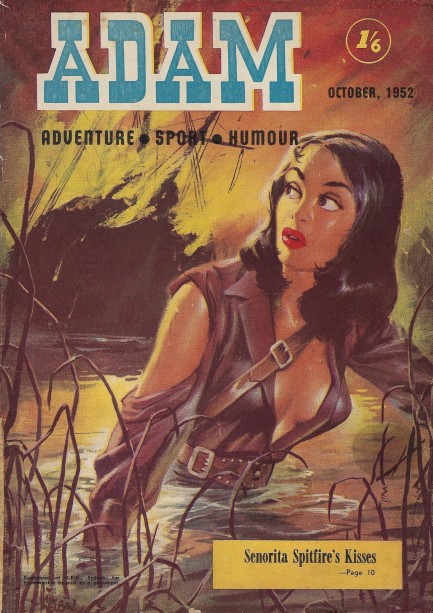
This issue of Adam published this month in 1952 is the second oldest issue of the magazine we've scanned and uploaded, and we gotta tell you, this thing was fragile as butterfly wings. But we got it done, and the magazine survived. The beautiful cover painting is signed by Phil Belbin, and it illustrates longtime pulp western writer Bob Obets' tale “Señorita Spitfire's Kisses”—let's just pause and enjoy that title, shall we? There's all sorts of promise in a title like that. It's simultaneously evocative and ridiculous, which often bodes well. The story is an adventure set on the Texas/Mexico border just after the U.S. Civil War. Basically, it's about a Mexican woman named Carlotta O'Farel y Cavazos who enlists the aid of a mercenary named Ricardo Ruby to cross the Rio Grande into Texas in search of a cache of money buried there. She plans to use it to buy guns for Mexican soldiers, while the captain is thinking maybe to have it for himself.
Here's a fun exchange (Ricardo refuses to call Carlotta by name at first, preferring to make up nicknames):
Ricardo: “Look, Flame of the River, just tell me where that eighty thousand is—and how come you know about it.”
Carlotta: “I was tellin' you, brains-of-a-donkey, the money is in this place call Corpus Christi, where my brother wait for the sheep to take this money to Cuba.”
Her insult really amused us for some reason. “Sheep,” by the way, is “ship” pronounced with an accent. Genre authors sometimes use phonetic spellings to portray accents, but it can cross the line into making the speaker sound stupid. It's something to avoid. After all, the presence of an accent means the speaker knows at least two languages, not just one, like most Americans. The most elegant authors, like Cormac McCarthy, write accents without alternate spellings. Obets opts for the clumsy method, having Carlotta say things like “sometheeng,” and “fineesh,” but he's a good writer anyway. In fact the story is good enough that we checked his bibliography. He's written at least two novels—1958's Blood Moon Range and 1965's Rails to the Rio. We may pick one up. In the meantime, we have a few scans, which include photos of Marie Windsor and Mari Blanchard. More Adam to come. 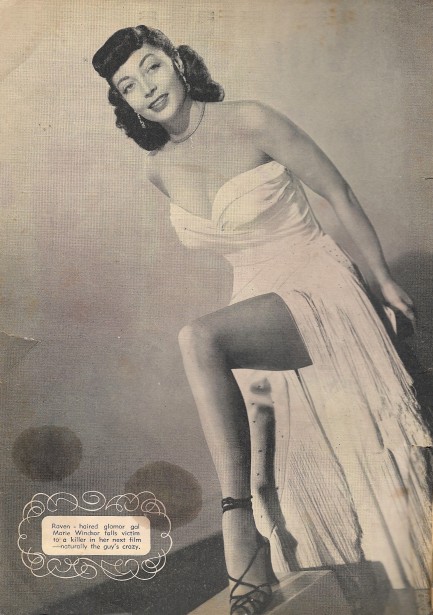 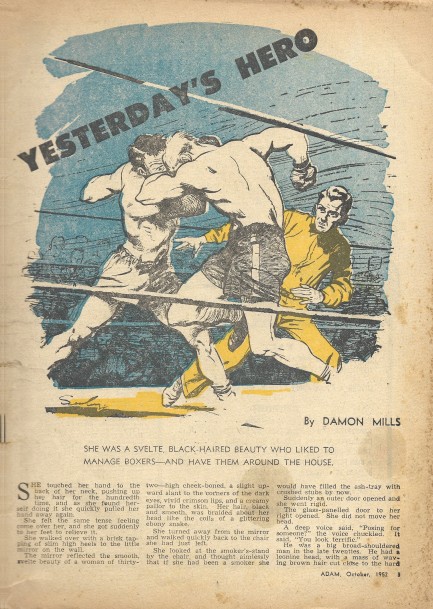 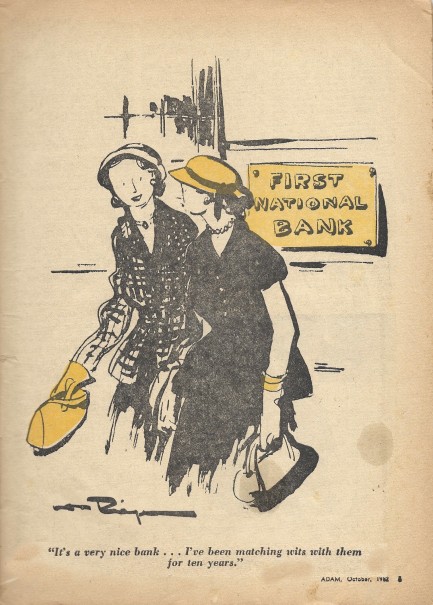 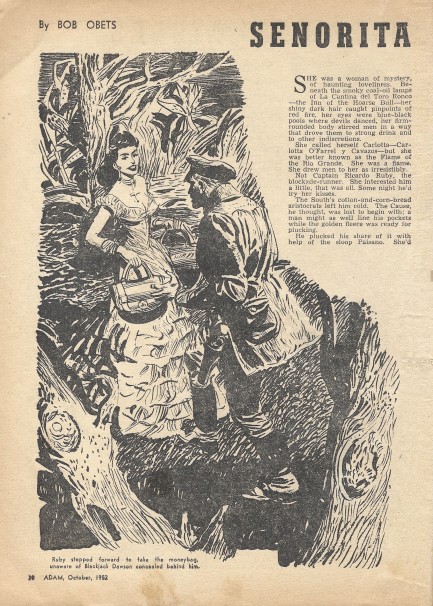 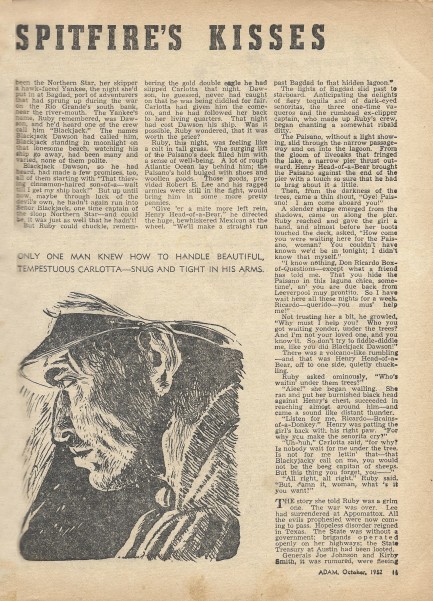 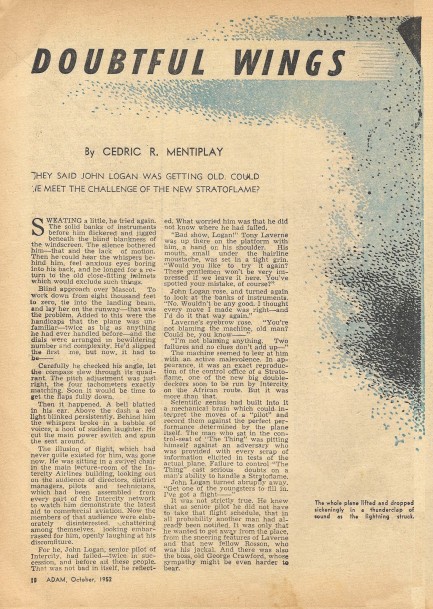 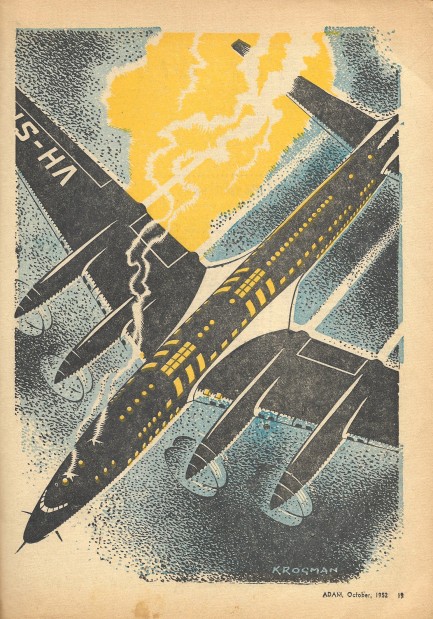 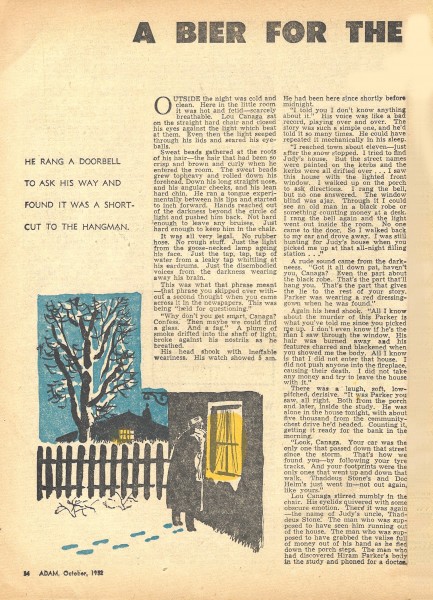 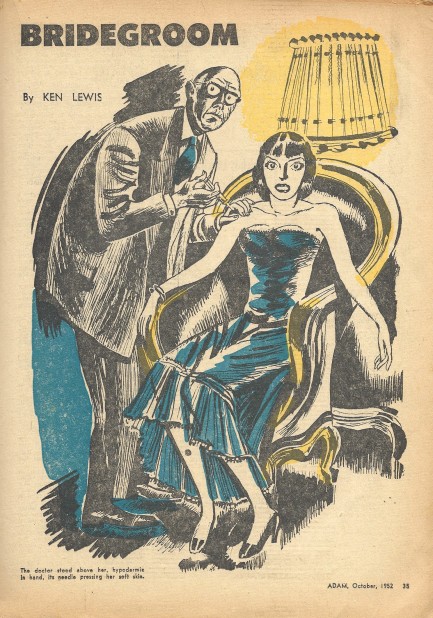 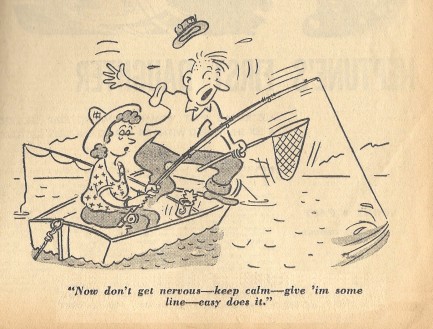 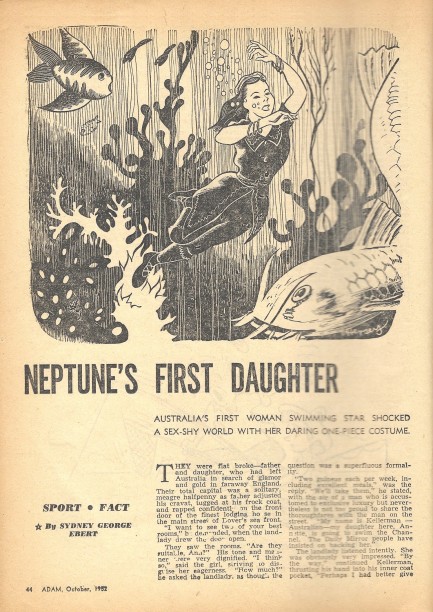 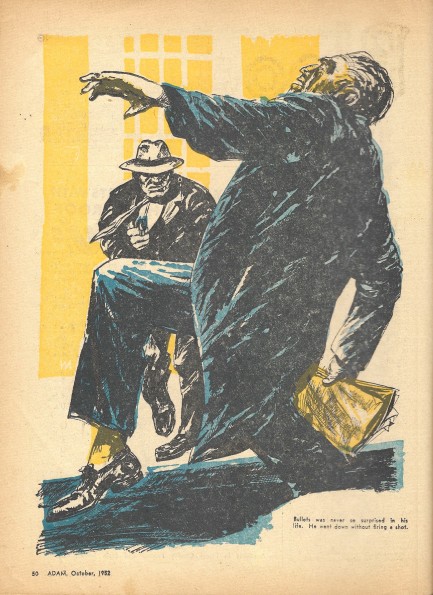 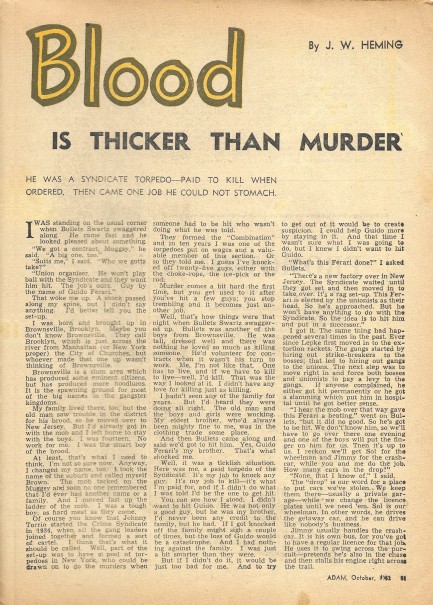 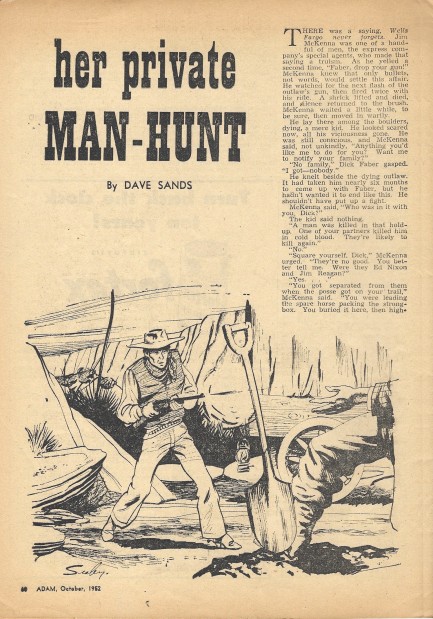 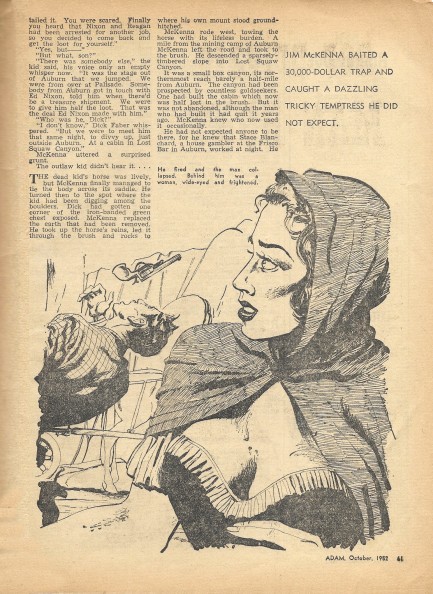 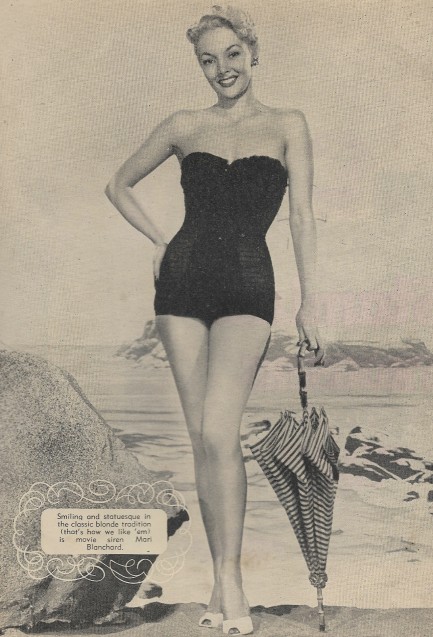 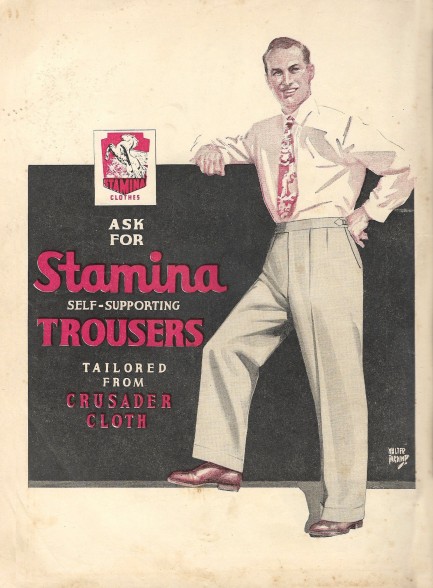
|
 |

The headlines that mattered yesteryear.
2003—Hope Dies
Film legend Bob Hope dies of pneumonia two months after celebrating his 100th birthday. 1945—Churchill Given the Sack
In spite of admiring Winston Churchill as a great wartime leader, Britons elect
Clement Attlee the nation's new prime minister in a sweeping victory for the Labour Party over the Conservatives. 1952—Evita Peron Dies
Eva Duarte de Peron, aka Evita, wife of the president of the Argentine Republic, dies from cancer at age 33. Evita had brought the working classes into a position of political power never witnessed before, but was hated by the nation's powerful military class. She is lain to rest in Milan, Italy in a secret grave under a nun's name, but is eventually returned to Argentina for reburial beside her husband in 1974. 1943—Mussolini Calls It Quits
Italian dictator Benito Mussolini steps down as head of the armed forces and the government. It soon becomes clear that Il Duce did not relinquish power voluntarily, but was forced to resign after former Fascist colleagues turned against him. He is later installed by Germany as leader of the Italian Social Republic in the north of the country, but is killed by partisans in 1945.
|

|
|

It's easy. We have an uploader that makes it a snap. Use it to submit your art, text, header, and subhead. Your post can be funny, serious, or anything in between, as long as it's vintage pulp. You'll get a byline and experience the fleeting pride of free authorship. We'll edit your post for typos, but the rest is up to you. Click here to give us your best shot.

|
|






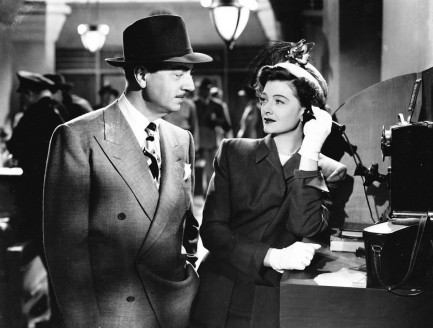
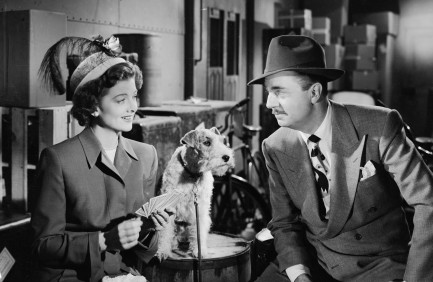
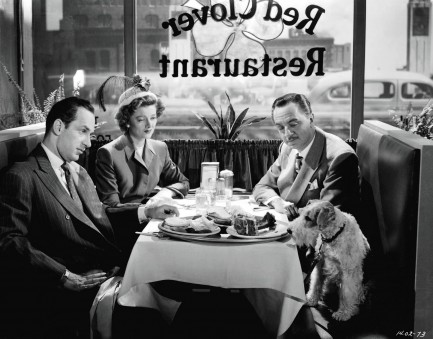
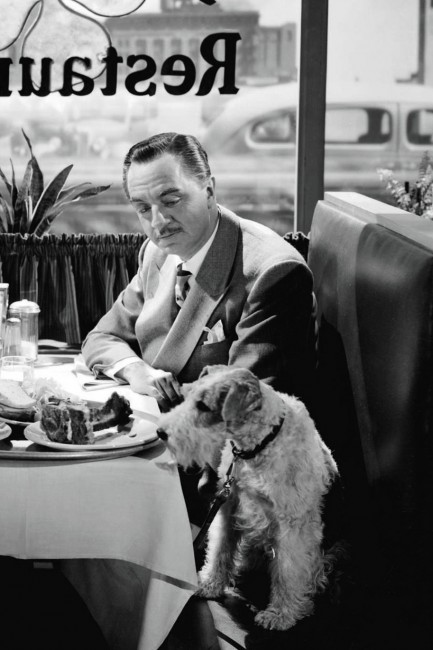
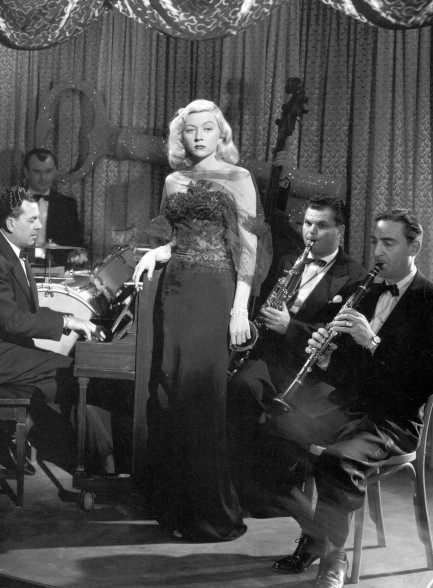
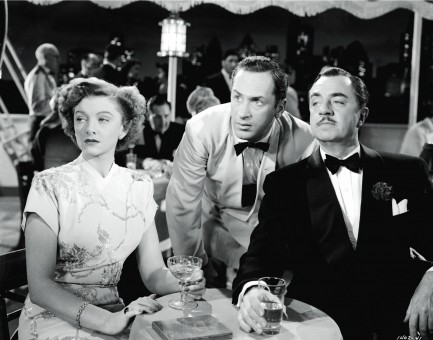
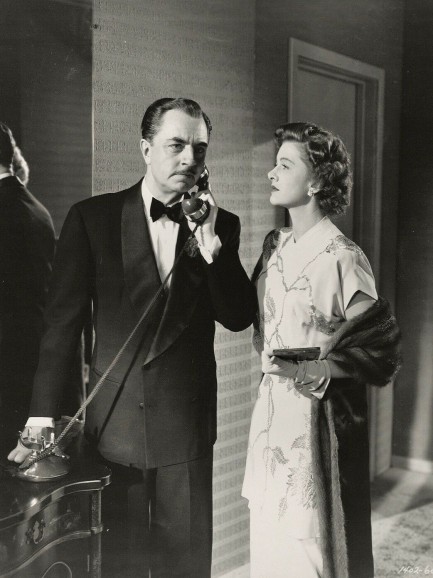
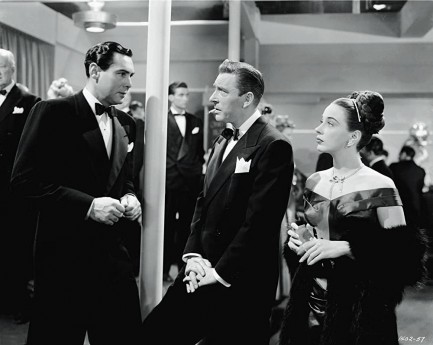
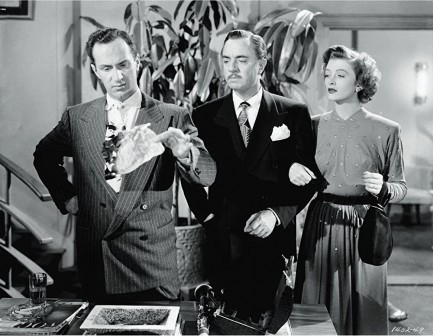

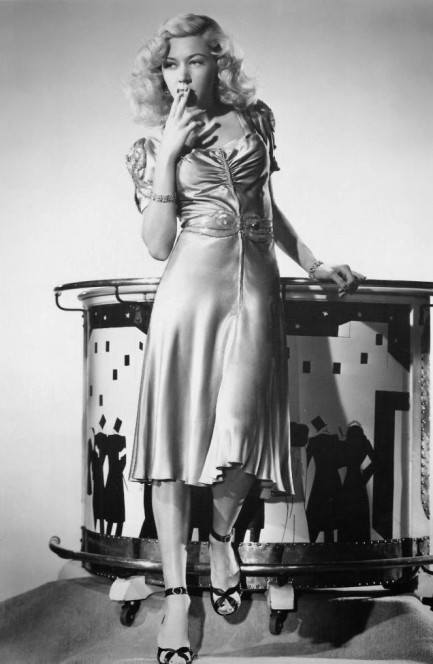
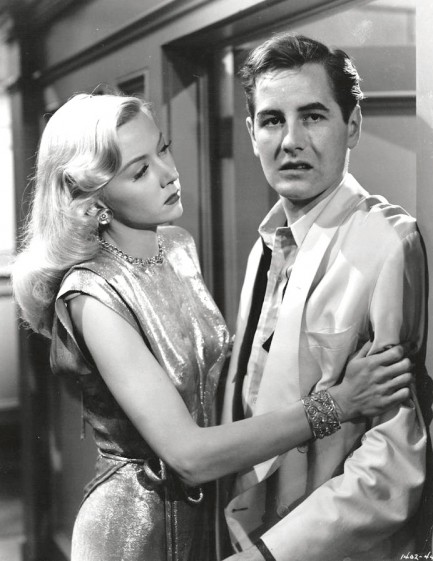
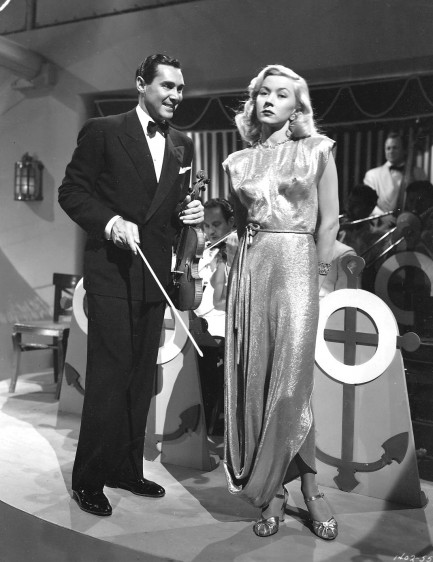
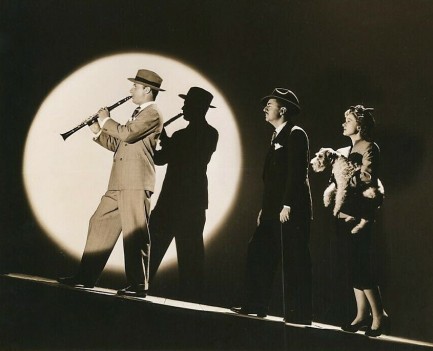


 Oh good Lord! She's been murdered and mutilated beyond recognition! Somebody call a doctor!
Oh good Lord! She's been murdered and mutilated beyond recognition! Somebody call a doctor! What the..! Don't you knock? I'm in the midst of a consultation here!
What the..! Don't you knock? I'm in the midst of a consultation here! I can advise you only informally until I hear back from the town's insurance network, Sheriff. But you might start with an immediate canvassing effort and a check for similar crimes in the state going back at least ten years.
I can advise you only informally until I hear back from the town's insurance network, Sheriff. But you might start with an immediate canvassing effort and a check for similar crimes in the state going back at least ten years. Actually, knowing there's a killer on the loose and any of us could be snuffed out next doesn't make me horny, Diana. But thanks for thinking of me.
Actually, knowing there's a killer on the loose and any of us could be snuffed out next doesn't make me horny, Diana. But thanks for thinking of me. Well, Sheriff, turns out the town has a three murder deductible. I'm afraid my hands are tied until a fourth person is slain.
Well, Sheriff, turns out the town has a three murder deductible. I'm afraid my hands are tied until a fourth person is slain.






 Broderick Crawford slaps Marlene Dietrich in the 1940's Seven Sinners.
Broderick Crawford slaps Marlene Dietrich in the 1940's Seven Sinners. June Allyson lets Joan Collins have it across the kisser in a promo image for The Opposite Sex, 1956.
June Allyson lets Joan Collins have it across the kisser in a promo image for The Opposite Sex, 1956. Speaking of Gilda, here's one of Glenn Ford and Rita Hayworth re-enacting the slap heard round the world. Hayworth gets to slap Ford too, and according to some accounts she loosened two of his teeth. We don't know if that's true, but if you watch the sequence it is indeed quite a blow. 100% real. We looked for a photo of it but had no luck.
Speaking of Gilda, here's one of Glenn Ford and Rita Hayworth re-enacting the slap heard round the world. Hayworth gets to slap Ford too, and according to some accounts she loosened two of his teeth. We don't know if that's true, but if you watch the sequence it is indeed quite a blow. 100% real. We looked for a photo of it but had no luck. Don't mess with box office success. Ford and Hayworth did it again in 1952's Affair in Trinidad.
Don't mess with box office success. Ford and Hayworth did it again in 1952's Affair in Trinidad. All-time film diva Joan Crawford gets in a good shot on Lucy Marlow in 1955's Queen Bee.
All-time film diva Joan Crawford gets in a good shot on Lucy Marlow in 1955's Queen Bee. The answer to the forthcoming question is: She turned into a human monster, that's what. Joan Crawford is now on the receiving end, with Bette Davis issuing the slap in Whatever Happened to Baby Jane? Later Davis kicks Crawford, so the slap is just a warm-up.
The answer to the forthcoming question is: She turned into a human monster, that's what. Joan Crawford is now on the receiving end, with Bette Davis issuing the slap in Whatever Happened to Baby Jane? Later Davis kicks Crawford, so the slap is just a warm-up. Mary Murphy awaits the inevitable from John Payne in 1955's Hell's Island.
Mary Murphy awaits the inevitable from John Payne in 1955's Hell's Island. Romy Schneider slaps Sonia Petrova in 1972's Ludwig.
Romy Schneider slaps Sonia Petrova in 1972's Ludwig. Lauren Bacall lays into Charles Boyer in 1945's Confidential Agent and garnishes the slap with a brilliant snarl.
Lauren Bacall lays into Charles Boyer in 1945's Confidential Agent and garnishes the slap with a brilliant snarl. Iconic bombshell Marilyn Monroe drops a smart bomb on Cary Grant in the 1952 comedy Monkey Business.
Iconic bombshell Marilyn Monroe drops a smart bomb on Cary Grant in the 1952 comedy Monkey Business. This is the most brutal slap of the bunch, we think, from 1969's Patton, as George C. Scott de-helmets an unfortunate soldier played by Tim Considine.
This is the most brutal slap of the bunch, we think, from 1969's Patton, as George C. Scott de-helmets an unfortunate soldier played by Tim Considine. A legendary scene in filmdom is when James Cagney shoves a grapefruit in Mae Clark's face in The Public Enemy. Is it a slap? He does it pretty damn hard, so we think it's close enough. They re-enact that moment here in a promo photo made in 1931.
A legendary scene in filmdom is when James Cagney shoves a grapefruit in Mae Clark's face in The Public Enemy. Is it a slap? He does it pretty damn hard, so we think it's close enough. They re-enact that moment here in a promo photo made in 1931. Sophia Loren gives Jorge Mistral a scenic seaside slap in 1957's Boy on a Dolphin.
Sophia Loren gives Jorge Mistral a scenic seaside slap in 1957's Boy on a Dolphin. Victor Mature fails to live up to his last name as he slaps Lana Turner in 1954's Betrayed.
Victor Mature fails to live up to his last name as he slaps Lana Turner in 1954's Betrayed. Ronald Reagan teaches Angie Dickinson how supply side economics work in 1964's The Killers.
Ronald Reagan teaches Angie Dickinson how supply side economics work in 1964's The Killers. Marie Windsor gets in one against Mary Castle from the guard position in an episode of television's Stories of the Century in 1954. Windsor eventually won this bout with a rear naked choke.
Marie Windsor gets in one against Mary Castle from the guard position in an episode of television's Stories of the Century in 1954. Windsor eventually won this bout with a rear naked choke. It's better to give than receive, but sadly it's Bette Davis's turn, as she takes one from Dennis Morgan in In This Our Life, 1942.
It's better to give than receive, but sadly it's Bette Davis's turn, as she takes one from Dennis Morgan in In This Our Life, 1942. Anthony Perkins and Raf Vallone dance the dance in 1962's Phaedra, with Vallone taking the lead.
Anthony Perkins and Raf Vallone dance the dance in 1962's Phaedra, with Vallone taking the lead. And he thought being inside the ring was hard. Lilli Palmer nails John Garfield with a roundhouse right in the 1947 boxing classic Body and Soul.
And he thought being inside the ring was hard. Lilli Palmer nails John Garfield with a roundhouse right in the 1947 boxing classic Body and Soul. 1960's Il vigile, aka The Mayor, sees Vittorio De Sica rebuked by a member of the electorate Lia Zoppelli. She's more than a voter in this—she's also his wife, so you can be sure he deserved it.
1960's Il vigile, aka The Mayor, sees Vittorio De Sica rebuked by a member of the electorate Lia Zoppelli. She's more than a voter in this—she's also his wife, so you can be sure he deserved it. Brigitte Bardot delivers a not-so-private slap to Dirk Sanders in 1962's Vie privée, aka A Very Private Affair.
Brigitte Bardot delivers a not-so-private slap to Dirk Sanders in 1962's Vie privée, aka A Very Private Affair. In a classic case of animal abuse. Judy Garland gives cowardly lion Bert Lahr a slap on the nose in The Wizard of Oz. Is it his fault he's a pussy? Accept him as he is, Judy.
In a classic case of animal abuse. Judy Garland gives cowardly lion Bert Lahr a slap on the nose in The Wizard of Oz. Is it his fault he's a pussy? Accept him as he is, Judy. Robert Culp backhands Raquel Welch in 1971's Hannie Caudler.
Robert Culp backhands Raquel Welch in 1971's Hannie Caudler. And finally, Laurence Harvey dares to lay hands on the perfect Kim Novak in Of Human Bondage.
And finally, Laurence Harvey dares to lay hands on the perfect Kim Novak in Of Human Bondage. 












